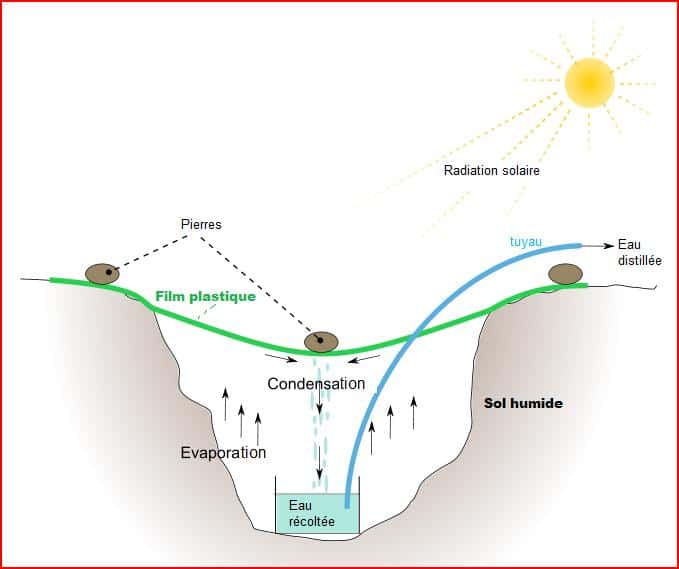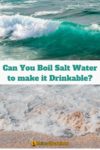We tend to take water for granted even though we can’t live without it. That’s hardly surprising given that water covers around 70% of the earth. The only problem is, only 2.5% of that water is drinkable. The rest is seawater.
Should disaster hit, you could easily find yourself far from a freshwater source but close to the sea. That salty water could be the key to your survival.
So Can you boil salt water to make it drinkable? No. Boiling salt water will sterilize it but won’t remove the salt.
Why Drinking Salt Water Isn’t The Key To Survival
Seawater contains around 3.5% salt, which is too much for a human to process. Our kidneys can, and do, remove excess salt from the body, but they need water to perform this function.
The salinity of seawater is so high that the kidneys can’t access enough freshwater to dilute the salt. To rid the body of the excess salt, they start producing more urine until the volume of urine is greater than the amount of water consumed. This imbalance causes dehydration.
If you continue to go without water once dehydrated, your body will try to compensate for the fluid loss by increasing the heart rate and constricting the blood vessels. This process restricts the flow of blood to the vital organs, causing them to fail.
How To Remove Salt From Seawater In The Wilderness
You need to remove both impurities and salt from seawater to make it drinkable.
99.999% of bacteria, viruses, pathogens, and protozoa die off when water reaches a temperature of 158°F. As water boils at 212°F, this is an effective way of purifying seawater, even though it will do little to remove the salt.
Alternatively, you could use either purification tablets or a survival water filter.
To remove the salt from seawater you need to distill the water. You can do this either by boiling it and collecting the steam or using the sun to evaporate the water.
As the water evaporates, leaving salt crystals and other particles behind. The vapor then rises and, as it cools, so it condenses, giving you clean, drinkable water.
Fortunately, you should have everything you need to both purify and desalinate in seawater in your bug-out bag.
Note the removed salt is also a valuable resource see: How to find salt in the wild.
Method 1: How To Make A Solar Still

- Dig a pit roughly 3ft by 3ft;
- In the center of your pit, dig another hole. This one should be large enough to house whatever container or receptacle you’re using to collect the water;
- Insert your water container;
- To improve the efficiency of your still, line the rest of the pit with leaves and other foliage;
- Cover your pit with a plastic tarpaulin (if you don’t have one, use an emergency poncho instead);
- Use rocks to hold the tarp in place;
- Push down on the center of the tarp until the sides slope inwards at a 45° angle;
- Use another small rock to hold the center of the tarp in position;
- The tarp should hang a few inches above your water container and should only touch the ground at the rim of the pit;
- Use more rocks to secure the edges and prevent any moisture from escaping.
As the sun heats the ground and vegetation under the tarp, it causes moisture to evaporate. This vapor collects on the inside of the tarp, cooling and condensing as it does so. That moisture will then run down the inside of the tarp into the container in the center of the pit.
On a hot day, this process takes just a couple of hours and can yield around a quart of water a day.
Expert tip:
It takes time and energy to create a solar still, so you don’t want to have to dismantle it every time you want a drink. To avoid that scenario, use some tubing to pipe the water out of the container, that way you can have a sip without removing the plastic tarp.
Method 2: How to Distill Water By Evaporation
For this method, you’ll need the following equipment:
- A cooking pot or heat proof container
- A condenser or cooling tube
- A second container to collect the condensation
If you don’t have any of these to hand, you can find natural alternatives. This video shows how to make a cooking pot and cooling tube from naturally occurring materials. And this post details how to boil water without a pot.
Whatever items you’re using to complete the process, the steps are the same:
- Fill your cooking pot with seawater;
- Insert one end of the cooling tube into the pot above the water level;
- Secure the pot with a lid;
- Place the other end of the tube in the second container;
- Place the water-filled container on a fire or similar heat source;
- Heat the pot until the water starts to boil;
- As the water boils, so the vapor travels through the tube, where it cools and condenses;
- This fresh water will collect in your second container.
Conclusion
You can’t make seawater drinkable simply by boiling it. You need the water vapor to evaporate off, leaving the salts and other nasties behind.
It’s a simple enough process and one that can be performed easily with little or no equipment. If you know how to make seawater drinkable, you’ll never go thirsty nor find yourself surrounded by water but without a drop to drink.



The video you attached to the article is inaccessible because the account was terminated
Thanks for sharing this article! I have always wanted to learn how to convert seawater into drinking water. Great stuff!
Thank you very much Very useful and simple explanation.